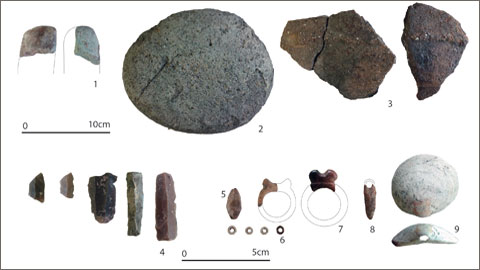La Draga campaign ends with the recovery of new objects

02/07/2015
The research team working on the excavations at the Neolithic site of La Draga (Banyoles, Girona), formed by archaeologists from the Universitat Autònoma de Barcelona (UAB) and the Spanish National Research Council (CSIC), recently presented the results of this year's campaign.
Their works focused on what is known as the A sector, close to where the excavations began at the site, and represent the continuity of digs begun in 2013 and 2014 as well as the finalisation of work in some of the subsoil graves and documentation of others. The remains recovered allow archaeologists to better reconstruct several parts of the daily life and social organisation of Neolithic societies, as well as obtain indicators for the reconstruction of the surrounding landscape and the impact human activity had on the area.
Among the objects there were skeletal remains of consumed animals, fragments of mills and other tools used to prepare food, fragments of ceramic bowls, remains of the manufacturing process of stone tools and ornamental elements such as beads and rings created with shells and bones. The diversity and quality of the ornamental elements confirm the symbolical and ideological value they had for the first farming and animal rearing communities.
The work at the site this year finalised on 3 July, earlier than in other years. The brevity of the work is caused by a reduction in financing, which makes it impossible to carry out longer digs and excavate in places where wooden architectonic elements are preserved, given the resources needed to examine and conserve them.
Despite these economic setbacks the scientific project at La Draga continues to be carried out. Researchers highlight the important number of scientific communications presented at international conferences in recent years on the discoveries made at the site and the lifestyle of populations living in the area. As an example, they point out that in the past four years (2011-2014) project researchers participated in 20 international conferences held in the European and American continents, as well as in many meetings held throughout Spain. During those years, at total of 16 papers were published in important international scientific journals, and researchers collaborated in the publication of several books. According to the archaeologists, this gives the La Draga project great international visibility in the world of research into the earliest Neolithic societies, making it a trailblazers and a leading project in the work towards expanding the knowledge of pre-historic societies in Western Europe.
This year's campaign has included the participation of sixty people working on different excavation tasks. Although most participants come from somewhere in Catalonia, most of the students of the UAB bachelor's degree in Archaeology, other participants stem from other parts of Spain, as well as from Brazil, Serbia, Poland, France, Italy and Greece.
Twenty-Five Years of Excavation Campaigns
At La Draga, excavations have taken place during the past 25 years, under the coordination of the Archaeology Museum of Banyoles. Given the importance of the site, in 2008 a research project was built to continue works and includes the participation of the Universitat Autònoma de Barcelona, the Archaeology Museum of Catalonia and the Spanish National Research Council (IMF, Barcelona). The joint efforts of these institutions, different in nature and in objectives, has enabled archaeologists to take on a more complete approach towards the singularity of the site by conducting research tasks, training new researchers, conserving the remains discovered and disseminating all their findings.
The importance of this pre-historic village lies in the fact that it was one of the earliest sites in which a Neolithic farming and animal rearing community settled and transformed its surroundings to adapt them to their needs in order to survive. The most outstanding feature at the site is the conservation of elements built with wood and other organic materials, an exceptional feat for such an early society and which contributes to a more complete comprehension of these first farming and animal rearing communities.
Image: _Object recovered in the 2015 La Draga dig:
1.- Polished stone adzes
2.- Grinder
3.- Ceramic fragments decorated with smooth ribs
4.- Flintstone tools (arrow points and blades)
5.- Diamond-shaped shell necklace bead
6.- Round shell necklace beads
7.- Bone ring
8.- Necklace made with a perforated tooth
9.- Perforated shell used as a necklace